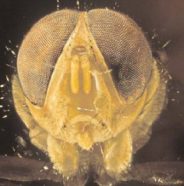How to silence a cricket
A killer fly stalks noise-making crickets in Hawaii.
By Eric Jaffe
Among the things that come to mind when thinking about night are darkness, the moon, bedtime, and, in many places, chirping crickets. The list may soon get shorter in the lowlands on the Hawaiian island of Kauai, where flies have targeted a type of cricket that originally came to Hawaii from the western Pacific.
 |
|
These cricket-stalking flies, known as Ormia ochracea, are about the size of houseflies but have big red eyes and fly at dawn or dusk. The flies pinpoint the source of a cricket chirp, and a female deposits larvae on the unlucky songster. As a result, male crickets on the Hawaiian island of Kauai are falling silent.
|
| R. Hoy and G. Haldeman |
Only male crickets chirp. They have special parts on their wings that, when scraped against each other, make a noise.
In the 1990s, a certain type of fly began hunting Polynesian field crickets found on Kauai, says Marlene Zuk of the University of California, Riverside.
These flies implant their babies in the bodies of crickets. The larvae use the crickets as food, and the crickets eventually die.
Because male crickets make so much noise, they’re easy to locate and suffer the most. So, within 5 years, the male crickets stopped chirping almost entirely, Zuk says.
By 2003, the cricket population had started increasing again, she reports, but only a few of the males had wings with chirping parts that still worked.
“What surprises me most is that the cricket song went away so fast,” says Ron Hoy of Cornell University, who also studies flies and crickets.
The change is an example of natural selection, which is part of the process of evolution. In this case, chirping was a bad quality for a cricket to have on Kauai, and cricket numbers were dropping.
A gene or two happened to change, or mutate, so that the cricket wing couldn’t chirp anymore. In some places, this change would have doomed the mutated crickets. But on Kauai, faced with deadly flies that could zero in on the sound, the mutated crickets thrived and passed the changes on to their young. Now, these silent crickets are the main type of cricket on the island.
Unfortunately for male crickets, their only way of attracting females is by chirping. For now, the silent males cluster around the few remaining chirpers in order to meet female crickets.—E. Jaffe
Going Deeper:
Milius, Susan. 2006. Crickets on mute: Hush falls as killer fly stalks singers. Science News 170(Sept. 23):197. Available at http://www.sciencenews.org/articles/20060923/fob5.asp .
For more about crickets, see www3.telus.net/~ecade/CricketsintheClassroom/
cricketsintheclassroom.html (Elsa Salazar Cade). William Cade and Elsa Salazar Cade discovered the song-tracking fly in 1975 and were the first to report that the female fly follows cricket chirps to deposit larvae on a male.
You can learn more about the cricket-stalking fly Ormia ochracea and its remarkable hearing at www.utsc.utoronto.ca/~amason/Ormia.htm (University of Toronto), www.npr.org/programs/re/archivesdate/
1999/jul/990712.ormia.html (NPR), and en.wikipedia.org/wiki/Ormia_ochracea (Wikipedia).
Science project idea: What factors affect the rate at which a cricket chirps? Information about raising crickets can be found at hobbyscience.com/bug.html (HobbyScience).







